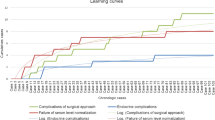Abstract
The surgical approach for hypophysectomy has undergone sweeping revolution in the past three decades. With the advent of endoscopes, better instrumentation, better illumination and viewing cameras, endoscopic endo-nasal trans-sphenoidal approach to sella has now largely become the norm. The aim of this study is to present our experience, analysing the surgical outcomes of this approach in patients with pituitary adenoma, pertaining to entirety of tumor removal, alleviation of symptoms and rate of complications. This prospective study was conducted at our tertiary health care centre from June 2012 to June 2015. A total of 14 patients, meeting the inclusion criteria, underwent endoscopic trans-sphenoidal hypophysectomy for pituitary adenoma. Age of presentation ranged from 19 to 73 years (mean 43.6 years). 9 patients were female and 5 were male. The most common presenting symptom was headache, followed by visual disturbances. Amongst those with hormonal imbalance, most common were prolactinomas and growth hormone secreting adenomas. Preoperative MRI brain showed macroadenomas in all 14 patients. 7 (50%) patients had suprasellar extension, while 5 (36%) patients had intracavernous extension too. CT paranasal sinuses provided the roadmap for surgery by identifying anatomical variations. Alleviation of headache occurred in all cases. Normalization of altered hormonal profile was seen in all cases. 83.3% of our patients with visual field defects on perimetry showed improvement post-surgery. Recidivism was directly related to the size and extent of adenoma. Transient diabetes insipidus was seen in 4 (28%) cases. Persistent diabetes insipidus occurred in 1 (7%) patient. CSF leak was seen in 2 (14%) patients, 1 (7%) patient developed postoperative meningitis. Most common nasal complication was excessive crusting. There was no incidence of any vascular complications, focal neurological deficit or hypopituitarism in our study. The pure endoscopic approach is a safe, efficacious, and minimally invasive technique for the removal of pituitary adenomas. The results have been encouraging in our prospective study. However, the importance of learning curve in endoscopic skull base surgery and use of a multi-disciplinary collaboration cannot be overemphasized.


Similar content being viewed by others
References
Liu JK, Das K, Weiss MH, Laws ER Jr, Couldwell WT (2001) The history and evolution of transsphenoidal surgery. J Neurosurg 95(6):1083–1096
Jankowski R, Auque J, Simon C, Marchal JC, Hepner H, Wayoff M (1992) Endoscopic pituitary tumor surgery. Laryngoscope 102:198–202
Stamm AC, Pignatari S, Vellutini E, Harvey RJ, Nogueira JF (2008) A novel approach allowing binostril work to the sphenoid sinus. Otolaryngology–Head and Neck Surgery, 138(4):531–532
De Klotz TR, Chia SH, Lu W, Makambi KH, Aulisi E, Deeb Z (2012) Meta-analysis of endoscopic versus sublabial pituitary surgery. Laryngoscope 122:511–518
Rotenberg B, Tam S, Ryu WH, Duggal N (2010) Microscopic versus endoscopic pituitary surgery: a systematic review. Laryngoscope 120:1292–1297
Goudakos JK, Markou KD, Georgalas C (2011) Endoscopic versus microscopic transsphenoidal pituitary surgery: a systematic review and meta-analysis. Clin Otolaryngol 36:212–220
Tabaee A, Anand VK, Barron Y, Hiltzik DH, Brown SM, Kacker A, Mazumdar M, Schwartz TH (2009) Endoscopic pituitary surgery: a systematic review and meta-analysis. J Neurosurg 111:545–554
Ammirati M, Wei L, Ciric I (2013) Short-term outcome of endoscopic versus microscopic pituitary adenoma surgery: a systematic review and meta-analysis. J Neurol Neurosurg Psychiatry 84:843–849
Liu JK, Christiano LD, Patel SK, Eloy JA (2011) Surgical nuances for removal of retrochiasmatic craniopharyngioma via the endoscopic endonasal extended transsphenoidal transplanum transtuberculum approach. Neurosurg Focus 30(4):E14
Cappabianca P, Cavallo LM, Esposito F, De Divitiis O, Messina A, De Divitiis E (2008) Extended endoscopic endonasal approach to the midline skull base: the evolving role of transsphenoidal surgery. Adv Tech Stand Neurosurg 33:151–199
Hofstetter CP, Shin BJ, Mubita L, Huang C, Anand VK, Boockvar JA (2011) Endoscopic endonasal transsphenoidal surgery for functional pituitary adenomas. Neurosurg Focus 30(4):e10
Sethi DS, Leong JL (2006) Endoscopic pituitary surgery. Otolaryngol Clin N Am 39:563–583
Hamid O, El Fiky L, Hassan O, Kotb A, El Fiky S (2008) Anatomic variations of the sphenoid sinus and their impact on trans-sphenoid pituitary surgery. Skull Base 18(1):9–15
Hadad G, Bassagasteguy L, Carrau RL, Mataza JC, Kassam A, Snyderman CH, Mintz A (2006) A novel reconstructive technique after endoscopic expanded endonasal approaches: vascular pedicle nasoseptal flap. Laryngoscope 116:1882–1886
Kerrison JB, Lynn MJ, Baer CA, Newman SA, Biousse V, Newman NJ (2000) Stages of improvement in visual fields aſter pituitary tumor resection. Am J Ophthalmol 130:813–820
Ho RW, Huang HM, Ho JT (2015) The influence of pituitary adenoma size on vision and visual outcomes after trans-sphenoidal adenectomy: a report of 78 cases. J Korean Neurosurg Soc 57(1):23–31. https://doi.org/10.3340/jkns.2015.57.1.23
Laws ER Jr, Kern EB (1976) Complications of trans-sphenoidal surgery. Clin Neurosurg 23:402–416
Cappabianca P, Cavallo LM, Valente V et al (2004) Sellar repair with fibrin sealant and collagen fleece after endoscopic endonasal transsphenoidal surgery. Surg Neurol 62:227–233
Kilty SJ, McLaughlin N, Bojanowski MW (2010) Extracranial complications of endoscopic transsphenoidal sellar surgery. J Otolaryngol Head Neck Surg 39:309–314
Cheng Y, Xue F, Wang T, Ji J, Chen W, Wang Z et al (2015) Analyses and treatments of postoperative nasal complications after endonasal transsphenoidal resection of pituitary neoplasms. J Neurosurg 122(6):1458–1465
Batra PS, Citardi MJ, Lanza DC (2005) Isolated sphenoid sinusitis after transsphenoidal hypophysectomy. Am J Rhinol 19:185–189
Dusick JR, Esposito F, Mattozo CA et al (2006) Endonasal transsphenoidal surgery: the patient’s perspective-survey results from 259 patients. Surg Neurol 65:332–342
Funding
No funding sources.
Author information
Authors and Affiliations
Corresponding author
Ethics declarations
Conflict of interest
The authors declare that they have no conflict of interest.
Ethical Approval
The study was approved by the Institutional Ethics Committee.
Additional information
Publisher's Note
Springer Nature remains neutral with regard to jurisdictional claims in published maps and institutional affiliations.
Rights and permissions
About this article
Cite this article
Aiyer, R.G., Upreti, G. Endoscopic Endo-nasal Trans-Sphenoidal Approach for Pituitary Adenomas: A Prospective Study. Indian J Otolaryngol Head Neck Surg 72, 36–43 (2020). https://doi.org/10.1007/s12070-019-01725-8
Received:
Accepted:
Published:
Issue Date:
DOI: https://doi.org/10.1007/s12070-019-01725-8




